Gamma rays as a signature of r-process producing supernovae: remnants and future Galactic explosions

Gamma rays as a signature of r-process producing supernovae: remnants and future Galactic explosions
Zhenghai Liu, Evan Grohs, Kelsey A. Lund, G. C. McLaughlin, M. Reichert, Ian U. Roederer, Rebecca Surman, Xilu Wang
AbstractWe consider the question of whether core-collapse supernovae (CCSNe) can produce rapid neutron capture process (r-process) elements and how future MeV gamma-ray observations could address this. Rare types of CCSNe characterized by substantial magnetic fields and rotation, known as magnetorotational supernovae (MR-SNe), are theoretically predicted to produce these elements, although direct observational evidence is lacking. We suggest that this critical question be addressed through the study of some of the eleven CCSN remnants located within 10 kpc, as well as through the detection of gamma-ray emission from a future Galactic supernova. We use a two-dimensional MR-SN model to estimate the expected gamma flux stemming from nuclear decays in the range of a few tens of keV to a few MeV. Our results indicate that an observation of Sn-126 (Sb-126) in a remnant stands out as a signature of an r-process-producing supernova. Since the neutron-rich conditions that lead to the production of the r-process could also enhance the production of Fe-60, the detection of substantial Fe-60 (Co-60) would be indicative of favorable conditions for the r-process. In the case of a future supernova explosion, when the evolution of the spectrum is studied over ten days to a few years, a rich picture emerges. At various epochs, second peak r-process isotopes such as Sb-125, I-131, Te-132, I-132 and La-140 produce gamma-ray signals that emerge above the background from explosive burning products and electron-positron annihilation. The weak r-process isotopes Nb-95, Ru-103, Rh-106 also have periods of prominence. While MR-SNe are predicted to have a relatively small main r-process contribution, third peak isotopes like Ir-194 could still be above next-generation MeV gamma instrument sensitivities.